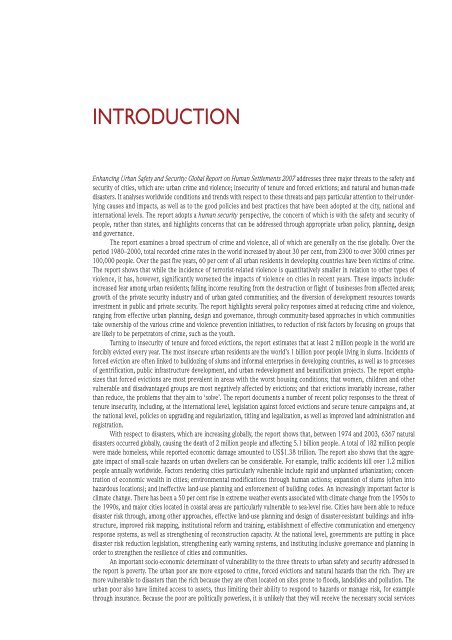Download the file - United Nations Rule of Law
Download the file - United Nations Rule of Law
Download the file - United Nations Rule of Law
- No tags were found...
You also want an ePaper? Increase the reach of your titles
YUMPU automatically turns print PDFs into web optimized ePapers that Google loves.
INTRODUCTIONEnhancing Urban Safety and Security: Global Report on Human Settlements 2007 addresses three major threats to <strong>the</strong> safety andsecurity <strong>of</strong> cities, which are: urban crime and violence; insecurity <strong>of</strong> tenure and forced evictions; and natural and human-madedisasters. It analyses worldwide conditions and trends with respect to <strong>the</strong>se threats and pays particular attention to <strong>the</strong>ir underlyingcauses and impacts, as well as to <strong>the</strong> good policies and best practices that have been adopted at <strong>the</strong> city, national andinternational levels. The report adopts a human security perspective, <strong>the</strong> concern <strong>of</strong> which is with <strong>the</strong> safety and security <strong>of</strong>people, ra<strong>the</strong>r than states, and highlights concerns that can be addressed through appropriate urban policy, planning, designand governance.The report examines a broad spectrum <strong>of</strong> crime and violence, all <strong>of</strong> which are generally on <strong>the</strong> rise globally. Over <strong>the</strong>period 1980–2000, total recorded crime rates in <strong>the</strong> world increased by about 30 per cent, from 2300 to over 3000 crimes per100,000 people. Over <strong>the</strong> past five years, 60 per cent <strong>of</strong> all urban residents in developing countries have been victims <strong>of</strong> crime.The report shows that while <strong>the</strong> incidence <strong>of</strong> terrorist-related violence is quantitatively smaller in relation to o<strong>the</strong>r types <strong>of</strong>violence, it has, however, significantly worsened <strong>the</strong> impacts <strong>of</strong> violence on cities in recent years. These impacts include:increased fear among urban residents; falling income resulting from <strong>the</strong> destruction or flight <strong>of</strong> businesses from affected areas;growth <strong>of</strong> <strong>the</strong> private security industry and <strong>of</strong> urban gated communities; and <strong>the</strong> diversion <strong>of</strong> development resources towardsinvestment in public and private security. The report highlights several policy responses aimed at reducing crime and violence,ranging from effective urban planning, design and governance, through community-based approaches in which communitiestake ownership <strong>of</strong> <strong>the</strong> various crime and violence prevention initiatives, to reduction <strong>of</strong> risk factors by focusing on groups thatare likely to be perpetrators <strong>of</strong> crime, such as <strong>the</strong> youth.Turning to insecurity <strong>of</strong> tenure and forced evictions, <strong>the</strong> report estimates that at least 2 million people in <strong>the</strong> world areforcibly evicted every year. The most insecure urban residents are <strong>the</strong> world’s 1 billion poor people living in slums. Incidents <strong>of</strong>forced eviction are <strong>of</strong>ten linked to bulldozing <strong>of</strong> slums and informal enterprises in developing countries, as well as to processes<strong>of</strong> gentrification, public infrastructure development, and urban redevelopment and beautification projects. The report emphasizesthat forced evictions are most prevalent in areas with <strong>the</strong> worst housing conditions; that women, children and o<strong>the</strong>rvulnerable and disadvantaged groups are most negatively affected by evictions; and that evictions invariably increase, ra<strong>the</strong>rthan reduce, <strong>the</strong> problems that <strong>the</strong>y aim to ‘solve’. The report documents a number <strong>of</strong> recent policy responses to <strong>the</strong> threat <strong>of</strong>tenure insecurity, including, at <strong>the</strong> international level, legislation against forced evictions and secure tenure campaigns and, at<strong>the</strong> national level, policies on upgrading and regularization, titling and legalization, as well as improved land administration andregistration.With respect to disasters, which are increasing globally, <strong>the</strong> report shows that, between 1974 and 2003, 6367 naturaldisasters occurred globally, causing <strong>the</strong> death <strong>of</strong> 2 million people and affecting 5.1 billion people. A total <strong>of</strong> 182 million peoplewere made homeless, while reported economic damage amounted to US$1.38 trillion. The report also shows that <strong>the</strong> aggregateimpact <strong>of</strong> small-scale hazards on urban dwellers can be considerable. For example, traffic accidents kill over 1.2 millionpeople annually worldwide. Factors rendering cities particularly vulnerable include rapid and unplanned urbanization; concentration<strong>of</strong> economic wealth in cities; environmental modifications through human actions; expansion <strong>of</strong> slums (<strong>of</strong>ten intohazardous locations); and ineffective land-use planning and enforcement <strong>of</strong> building codes. An increasingly important factor isclimate change. There has been a 50 per cent rise in extreme wea<strong>the</strong>r events associated with climate change from <strong>the</strong> 1950s to<strong>the</strong> 1990s, and major cities located in coastal areas are particularly vulnerable to sea-level rise. Cities have been able to reducedisaster risk through, among o<strong>the</strong>r approaches, effective land-use planning and design <strong>of</strong> disaster-resistant buildings and infrastructure,improved risk mapping, institutional reform and training, establishment <strong>of</strong> effective communication and emergencyresponse systems, as well as streng<strong>the</strong>ning <strong>of</strong> reconstruction capacity. At <strong>the</strong> national level, governments are putting in placedisaster risk reduction legislation, streng<strong>the</strong>ning early warning systems, and instituting inclusive governance and planning inorder to streng<strong>the</strong>n <strong>the</strong> resilience <strong>of</strong> cities and communities.An important socio-economic determinant <strong>of</strong> vulnerability to <strong>the</strong> three threats to urban safety and security addressed in<strong>the</strong> report is poverty. The urban poor are more exposed to crime, forced evictions and natural hazards than <strong>the</strong> rich. They aremore vulnerable to disasters than <strong>the</strong> rich because <strong>the</strong>y are <strong>of</strong>ten located on sites prone to floods, landslides and pollution. Theurban poor also have limited access to assets, thus limiting <strong>the</strong>ir ability to respond to hazards or manage risk, for examplethrough insurance. Because <strong>the</strong> poor are politically powerless, it is unlikely that <strong>the</strong>y will receive <strong>the</strong> necessary social services
















